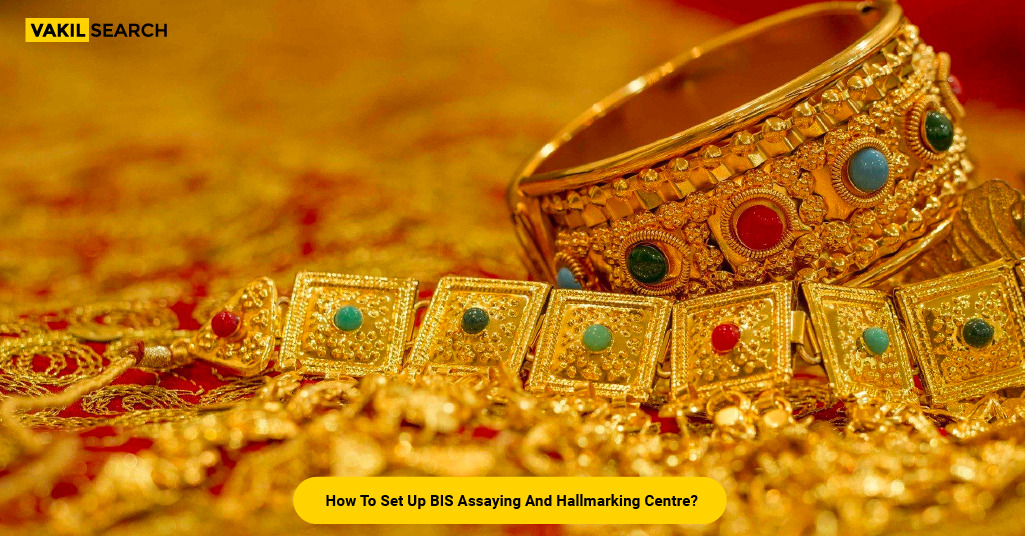This article explains the hallmarking scheme of the Bureau of Indian Standards (BIS) for gold and other precious metals. It covers the mandatory hallmarking of gold jewellery in India, its implementation in two phases, the hallmarking process, and its importance in consumer protection.
Gold has been a popular form of investment and adornment in India for centuries. However, consumers often face the challenge of determining the purity of the gold they buy. This is where hallmarking comes into play. In this article, we’ll explain what hallmarking of gold jewellery is and its importance in India.
What is Hallmarking?
Hallmarking is the process of certifying the purity of gold by a Bureau of Indian Standards (BIS) certified center. It involves testing and analysing the metal content of the gold and imprinting it with a stamp that signifies its purity.
The hallmarking system in India is regulated by the BIS, a government body that oversees the standardisation, marking, and quality control of various consumer products. The BIS has set a standard for hallmarking gold in India that ensures the quality and purity of the metal.
The hallmarking process involves melting a small sample of gold in a cupel and analysing the metal content using various chemical and physical tests. The sample is then stamped with a mark indicating the gold’s purity, the year of hallmarking, and the hallmarking centre’s identification number.
Importance of Hallmarking in India
Hallmarking of gold jewellery is important for both consumers and jewellers. For consumers, it ensures that they are buying genuine and pure gold. This is particularly important because of the prevalence of counterfeit and low-quality gold in the market.
Hallmarked gold also has a higher resale value than non-hallmarked gold. Since the purity of hallmarked gold is guaranteed, it is easier to sell it in the future.
For jewellers, hallmarking provides a competitive edge by distinguishing their products from others in the market. Hallmarking also helps in building customer trust and confidence, leading to increased sales.
Mandatory Hallmarking of Gold Jewellery in India
The Indian government has made hallmarking mandatory for all gold jewellery from June 1, 2021. This means that all gold jewellery sold in India must be hallmarked by a BIS-certified centre.
The government’s decision to make hallmarking mandatory is a welcome move that will benefit both consumers and jewellers. It will help in curbing the sale of fake and low-quality gold in the market and ensure that consumers get genuine and pure gold.
Hallmarking Scheme of BIS
The hallmarking scheme of the Bureau of Indian Standards (BIS) is a system that certifies the purity of gold and other precious metals. It is a voluntary scheme that is open to all jewellers and hallmarking centers in India. The scheme is designed to provide assurance to consumers that the gold they are purchasing is of a certain purity level and is certified by a BIS-certified hallmarking center.
Mandatory Hallmarking of Gold Jewellery
The Indian government made hallmarking of gold jewellery mandatory from June 1, 2021. This decision was taken to ensure that consumers get genuine and pure gold and to curb the sale of fake and low-quality gold in the market. The mandatory hallmarking rule is being implemented in two phases.
First Phase
The first phase of mandatory hallmarking began on June 1, 2021, and applied to 256 districts in India. In these districts, all gold jewellery sold must be hallmarked with the BIS standard mark, the purity in carats, and the identification mark of the hallmarking center.
Second Phase
The second phase of mandatory hallmarking will begin on June 1, 2022. It will apply to all districts in India, and all gold jewellery sold must be hallmarked with the BIS standard mark, the purity in carats, and the identification mark of the hallmarking center.
Hallmarking of Jewelry
Hallmarking of jewellery involves testing and certifying the metal content of gold or other precious metals. It is a process that assures consumers that they are purchasing genuine and pure gold. The hallmarking process involves melting a small sample of gold in a cupel and analysing the metal content using various chemical and physical tests. Once the purity of the gold is determined, the sample is stamped with a mark that signifies its purity level and the hallmarking center’s identification number.
Click Now: Hallmark Registration
Consumer Protection
The hallmarking of gold jewellery provides consumer protection by ensuring that they are purchasing genuine and pure gold. Consumers can easily identify the purity of the gold they are buying by looking for the hallmarking stamp. This helps in curbing the sale of fake and low-quality gold in the market and ensures that consumers get their money’s worth. Additionally, hallmarking also helps in building customer trust and confidence, leading to increased sales for jewellers.
In Conclusion
Hallmarking of gold jewellery is an important process that ensures the purity and quality of the gold. It is regulated by the BIS in India and involves testing and certifying the metal content of gold. Hallmarked gold has a higher resale value and provides a competitive edge to jewellers. The government’s decision to make hallmarking mandatory is a step in the right direction and will help in ensuring the purity of gold sold in the market.
If you would like to know more about hallmarking of gold jewellery in India, Vakilsearch can help. Our team of experts can provide you with legal assistance and help you understand the hallmarking process in detail. Our experienced lawyers can guide you through the entire process and answer any questions you may have about hallmarking of gold jewellery.
Also, Read:



